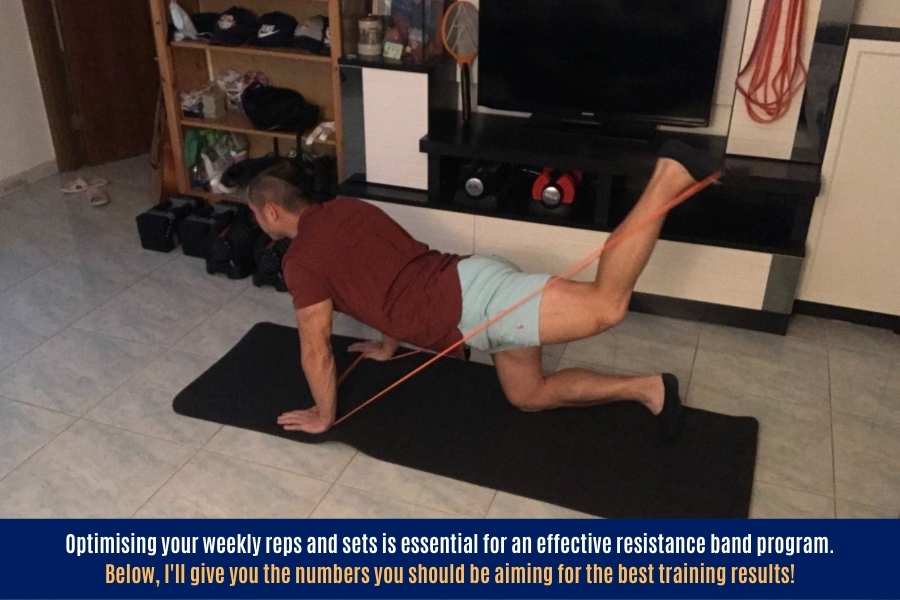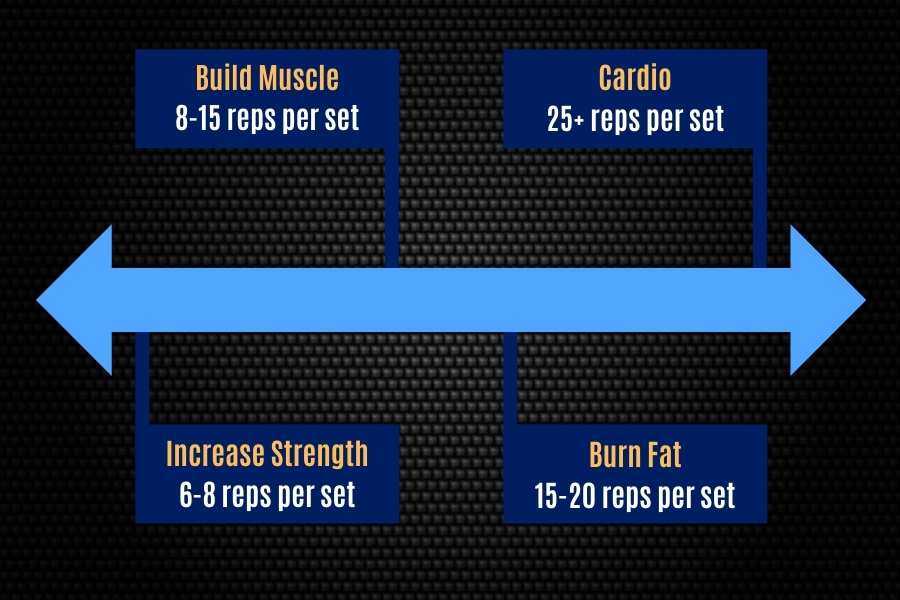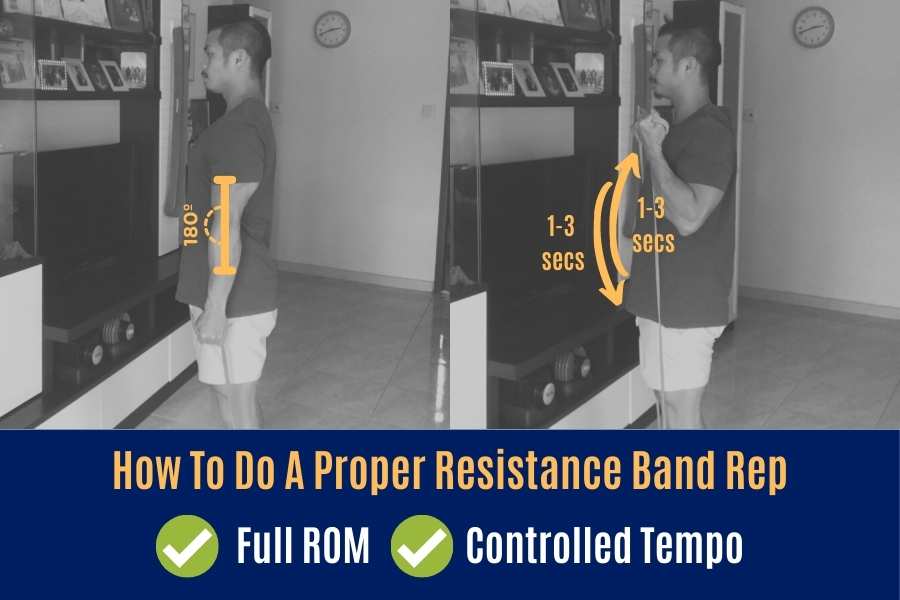If you’re new to resistance band training, it can be difficult to gauge exactly how many reps and sets you should be completing. If you do too much, you risk overtraining. But doing too little and you’ll never reach your training goal. So what’s the magic number?
Beginners should complete 6-15 reps per set of resistance band exercises. This is sufficient to build muscle, develop strength, and tone the body. In contrast, it is recommended to complete 10 total sets per muscle group per week, and not exceed more than 6 sets per exercise per workout.
These recommendations are based on scientific research and my personal 5-year resistance band training experience.
You can keep on reading to find out how I came to these recommendations!

- Recommended Reps For Resistance Bands
- Why Doing Too Few Reps Using Resistance Bands Can Be Bad
- Why Doing Too Many Reps Using Resistance Bands Can Be Bad
- Recommended Sets For Resistance Bands
- Why Doing Too Few Sets Using Resistance Bands Can Be Bad
- Why Doing Too Many Sets Using Resistance Bands Can Be Bad
- Best Way To Lift Reps With Resistance Bands
- Is It Possible To Overtrain With Resistance Bands?
- Conclusion
Recommended Reps For Resistance Bands
It is generally recommended to perform 6 to 15 repetitions per set when using resistance bands. This rep range is ideal for muscle strength and size gains. Individuals who are looking to burn fat or increase cardiovascular fitness may perform up to 25 or more reps per set.

You can see that the best number of reps for resistance bands can vary slightly depending on your training goal, as follows:
| Training Goal | Recommended Resistance Band Reps | Reason |
|---|---|---|
| Increase muscle strength | 6 to 8 reps per set | Low reps allow for the heaviest resistance bands to be used to maximize muscular strength and power generation. |
| Build muscle size | 8 to 15 reps per set | Moderate reps facilitate a balance between challenging band weights and overall training volume for muscle growth. |
| Burn fat | 15 to 20 reps per set | Moderately high reps allow for lifting challenging weights at relatively high reps to burn maximal calories during and after a workout. |
| Improve cardiovascular fitness | Up to 25+ reps per set | High reps allow for sustained resistance band activity using light weights and this is ideal for increasing heart rate. |
Generally speaking:
- Lower reps using a higher resistance facilitates muscle strength and size gains.
- Higher reps using a lower resistance facilitate fat loss and cardiovascular improvements.
Regardless of how many reps you choose to perform using your resistance bands, it’s essential to use a resistance (weight) that actually challenges you for the specified rep range.
In other words, don’t use “high reps lightweight” as an excuse to go for the lightest resistance band that you could lift with your little finger!
When choosing resistance band color and weight, a good rule to follow is that the last few reps of each set should induce muscular fatigue.
Why Doing Too Few Reps Using Resistance Bands Can Be Bad
Did you know that rep range recommendations are there for a reason?
Here’s why it can be bad to do too few reps during a resistance band workout:
- Too low reps can lead to insufficient intensity. Intensity refers to how much you exert yourself during a resistance band workout. If you’re not performing enough reps, then you may simply not be doing the work required to build muscle, lose fat, and become fitter.
- Too low reps reduce time under tension. Muscle time under tension (TUT) refers to the length of time a muscle remains contracted during a set. It’s a key stimulus for muscle growth. If you’re not lifting enough reps using your resistance bands, TUT may be insufficient to drive muscle development.
- Too low reps can promote excessive weight to be lifted. In contrast to not lifting with enough intensity, low reps can also tempt you to lift TOO MUCH weight. This can be just as bad for a resistance band workout (see next 3 points).
- Too much weight can promote bad lifting form. If you’re trying to do low reps using a resistance band that’s too heavy for you, then chances are your lifting form will be compromised. This can reduce the effectiveness of your resistance band workout.
- Bad lifting form reduces target muscle activation. Lifting an overly heavy resistance band with bad form forces you to overcompensate by recruiting neighboring muscles to help you lift the band. A classic example is swinging your hips and legs to bicep curl a band that’s too heavy for you. This results in less biceps activation.
- Bad lifting form can increase injury risk. Low reps using a resistance band that’s too heavy for you can increase your risk of injury due to bad lifting form.
Why Doing Too Many Reps Using Resistance Bands Can Be Bad
Just like with most things in life, moderation is key when deciding how many reps to do with resistance bands.
As I discussed previously, doing too few reps may mean you’re not challenging your muscles enough.
But doing too many reps may cause you to overexert yourself.
Here’s why it can be bad to do too many reps during a resistance band workout:
- Not enough intensity for hypertrophy. Together with TUT, mechanical tension (i.e. a sufficient weight) is the other primary stimulus for muscle growth. So if you’re goal with resistance band training is to increase muscle size and tone, you should avoid doing too high reps which forces you to reduce weight.
- Increases risk of overtraining. Using your bands to perform high reps at heavy resistance levels is a recipe for overtraining. This happens when the workload you’re doing is more than your muscles can recover from. As a result, you feel overly fatigued and may even injure yourself.
- Prolonged workouts. The final reason why doing too many resistance band reps is bad is that it prolongs your workout considerably. And most people want to avoid this. Reduce the reps and increase the resistance instead!
Interestingly, this 2015 study found that high and low reps can both actually build muscle equally well assuming enough weight is used to push your muscles to failure (the point where you cannot physically squeeze out another rep.
So it’s down to personal preference regarding which method you choose to adopt.
I prefer lower reps using a heavier resistance because it leads to a quicker workout.
But some bodybuilders stand by high rep band training to maximize training volume for the best muscle size gains.
If you’re new to band workouts, you may also be interested in my other article which explains how long a resistance band workout should be!
Recommended Sets For Resistance Bands
It is generally recommended to perform 3 to 6 sets per exercise when using resistance bands. Furthermore, beginners should aim for 10 total sets per muscle group per week. This ensures a sufficient training stimulus is completed without increasing the risk of overtraining.

It’s good practice to vary the number of resistance band sets you to perform based on the number of workouts you complete each week.
The overall goal is to aim for 10 total sets per week.
Here are some examples of how you can achieve the optimum number of resistance band reps per week:
| Number Of Sets Per Resistance Band Workout | Number Of Resistance Band Workouts Per Week | Total Number Of Weekly Sets |
|---|---|---|
| 3 | 3 | 9 |
| 5 | 2 | 10 |
| 4 | 3 | 12 |
You can see that the number of weekly resistance band sets for a particular muscle group always hovers at around 10 per week.
Generally speaking, doing fewer workouts per week means you should do more sets per workout (and vice versa).
If you’re doing resistance band workouts for general fitness or fat loss, you could do slightly fewer weekly sets and that would still be ok.
But if you’re working out for muscle and cardio gains, then try sticking to the above recommendations!
These recommendations will help you perform a sufficient amount of workload to see the best health benefits, maximize muscle growth, and ensure muscle tone development.
Why Doing Too Few Sets Using Resistance Bands Can Be Bad
As you now know, a minimum amount of weekly workload is essential to gaining the best benefits from resistance band training.
And this is best achieved by completing a sufficient number of weekly sets.
Here are some reasons why doing too few sets using resistance bands can be bad:
- Insufficient workload. It doesn’t matter if you’re trying to lose fat, build muscle, or increase strength. If you’re not doing enough work every week, then you’re muscles simply won’t adapt to your training and it will take you much longer to see results.
- Not enough TUT. If you’re resistance band training to build muscle, then doing too few weekly sets means your muscles aren’t seeing the TUT stimulus it needs to grow.
- Longer to reach training goals. As a result of the above, it will take you much longer to get bigger, toned, slim down, or whatever your training goal is!
Why Doing Too Many Sets Using Resistance Bands Can Be Bad
Just like how there’s an optimal rep range, there’s also an optimal number of sets you should be performing with resistance band workouts.
Doing too few sets and you risk underworking.
But the opposite is also true- doing too many sets could also be disadvantageous.
Here are some reasons why doing too many sets using resistance bands can be bad:
- Wasted sets and diminishing returns. This 2018 study concluded that doing more than 5 sets per muscle per workout does not lead to any more added benefits. In other words, resistance band training follows the law of diminishing returns. Doing more than 5 sets per muscle per workout could lead to wasted sets and time.
- Increased risk of overtraining. It can be tempting for a beginner to overexert themselves under the premise that the more work you put in then the more results you get back. Whilst this is true to a certain extent, you should also remember that your muscles need time to recover, adapt, and get stronger. Hitting them with too many sets can delay recovery.
- Increased risk of injury. Overtraining leads to an increased risk of injury.
- Impaired recovery. You want to be feeling fresh at the start of every workout. If you’re doing too many sets, you may find your muscles still sore at the start of a resistance band workout. This negatively impacts your training performance.
- Longer to reach training goals. As a result of the above, you may take significantly longer to build muscle, strength, and tone. It may also take you longer to burn fat and lose weight.
For more tips on resistance band training, you can check out my 10-step guide to effectively using resistance bands at home!
Best Way To Lift Reps With Resistance Bands
Resistance band reps are best performed using slow and controlled movements. The upward phase and downward phase should follow a 1-3 second tempo each. Additionally, it is recommended to lift bands using a full range movement. This involves fully flexing and extending the target joint.

Let’s dive deeper into how to best do reps using resistance bands:
- Slow and controlled 1-3 second tempo. A resistance band movement comprises a concentric (upward) and eccentric (downward) phase. These should both last 1-3 seconds each. So the total time it takes to complete a movement should be 2-6 seconds. This increases TUT and leads to higher muscle activation.
- Lift with a full range of motion. A full range of motion (ROM) means moving your joints within their maximum physical range. In a bicep curl example, this would mean your forearms should be fully extended at the bottom of the eccentric phase, and your hands should be almost touching your shoulders at the top of the concentric phase.
By combining slow and controlled movements with a full ROM, you’ll gain the biggest benefits from your resistance band reps!
For more details, you can check out my other article which explains how and why resistance bands actually work so well!
Is It Possible To Overtrain With Resistance Bands?
Just like with any type of physical training, it is possible to overtrain with resistance bands. Beginners are recommended to follow the recommended rep ranges and the weekly number of sets to avoid overexerting their muscles beyond the rate of recovery.
Overtraining usually happens when you work your muscles too hard, don’t give them enough time to rest between workouts, and consume inadequate nutrition.
From my experience, it’s much harder to overtrain using resistance bands than it is with free weights like barbells and dumbbells.
That’s because bands are generally less stressful on your joints and muscles compared to weights.
But it can still happen if you aren’t careful.
Here are some signs you may be overtraining with resistance bands:
- Extremely sore muscles.
- Delayed recovery.
- Impaired performance.
- Low mood.
- Pain.
The good news is that if you follow the rep and set recommendations and eat sensibly, then you are unlikely to overtrain from your resistance band workouts!
Conclusion
I’ve explained how many reps and sets you should be completing for your resistance band workouts.
The average beginner is recommended to do 6-15 reps per set for most resistance band training goals including muscle-building, strength development, and toning.
If you’re looking to lose weight or improve your cardio, then you can complete up to 25+ reps per set using a lighter weight.
Regardless of your chosen rep range, it’s important to use a band resistance that actually challenges you for those reps.
Furthermore, beginners should start resistance band training by completing 10 sets per muscle group per week, and not exceeding more than 6 sets per muscle group per workout.
How many reps and sets do you complete for your resistance band workouts?
Feel free to send me a message if you have any questions! You can find my details on the “contact us” page.
You may also be interested in the downloadable Kalibre Blueprint PDF which details exactly how I gained 40lbs of lean muscle (it’s 100% free!). It details the exact exercises and nutrition (with printable worksheets) I used to go from skinny to ripped!
Thanks for reading guys!
Peace Out,
Kal
(Biochemistry BSc, Biomedical Sciences MSc, Ex-Skinny Guy)


